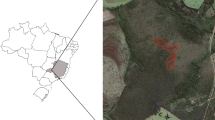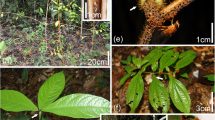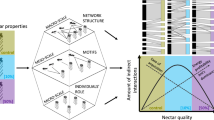Abstract
In natural environments, distinct species interact with differing level of specialization, and thereby generate complex interaction networks. Recent studies have shown that certain antagonistic and mutualistic networks have a highly modular structure. This indicates that within an ecological network, densely connected semi-independent compartments occur and reflect different levels of the structural and functional system. Despite strong evidence for the existence of a modular structure in obligate and symbiotic networks involving ants and myrmecophytes, it is still uncertain whether these networks are modular. Here, we used the modularity index (M) to evaluate whether symbiotic ant–myrmecophyte networks exhibit a modular pattern of interactions. The analyses were based on a large data set of ant–myrmecophyte networks collected in mature and secondary forests of the Brazilian Central Amazon. Our results indicate that symbiotic ant–myrmecophyte networks are highly modular (M = 0.53 ± 0.13) regardless of forest type. Using other network descriptors, we found no difference in links per species (Links = 0.68 ± 0.15) and network connectance (C = 0.31 ± 0.17) among the different types of forest. Furthermore, the composition of ants and myrmecophytes did not differ among forest types (ANOSIM; P > 0.05), reinforcing the idea that this symbiotic interaction can be resistant to different local and landscape environmental factors. In summary, this study contributes to a better understanding of the way biodiversity is organized in obligate and symbiotic ant–plant mutualisms.


Similar content being viewed by others
References
Ayala FJ, Wetterer JK, Longino JT, Hartl DL (1996) Molecular phylogeny of Azteca ants (Hymenoptera: Formicidae) and the colonization of Cecropia trees. Mol Phylogenet Evol 5:423–428
Bascompte J, Jordano P, Melián CJ, Olesen JM (2003) The nested assembly of plant–animal mutualistic networks. Proc Natl Acad Sci USA 100:9383–9387
Benson WW (1985) Amazon ant–plants. In: Prance GT, Lovejoy TE (eds) Amazonia. Pergamon Press, New York, pp 239–266
Blüthgen N, Menzel F, Hovestadt T, Fiala B, Blüthgen N (2007) Specialization, constraints, and conflicting interests in mutualistic networks. Curr Biol 17:341–346
Bruna EM, Vasconcelos HL, Heredia S (2005) The effect of habitat fragmentation on communities of mutualists: a test with Amazonian ants and their host plants. Biol Conserv 124:209–216
Corbet SA (2000) Conserving compartments in pollination webs. Conserv Biol 14:1229–1231
Dáttilo W (2012) Different tolerances of symbiotic and nonsymbiotic ant–plant networks to species extinctions. Net Biol 2:127–138
Dáttilo W, Marques EC, Falcão JCF, Moreira DDO (2009a) Interações mutualísticas entre formigas e plantas. EntomoBrasilis 2:32–36
Dáttilo W, Izzo TJ, Inouye BD, Vasconcelos HL, Bruna EM (2009b) Recognition of host plant volatiles by Pheidole minutula Mayr (Myrmicinae), an amazonian ant–plant specialist. Biotropica 41:642–646
Dáttilo W, Rico-Gray V, Rodrigues DJ, Izzo TJ (2013) Soil and vegetation features determine the nested pattern of ant–plant networks in a tropical rainforest. Ecol Entomol (in press)
Davidson DW, Snelling RR, Longino JT (1989) Competition among ants for myrmecophytes and the significance of plant trichomes. Biotropica 21:64–73
Díaz-Castelazo C, Guimarães PR, Jordano P, Thompson JN, Marquis RJ, Rico-Gray V (2010) Changes of a mutualistic network over time: reanalysis over a 10-year period. Ecology 91:793–801
Dupont YL, Olesen JM (2009) Ecological modules and roles of species in healthland plant–insect flower visitor networks. J Anim Ecol 78:346–353
Faegri K, Van Der Pijl L (1979) The principles of pollination ecology. Pergamon Press, Oxford
Ferdele W, Maschwitz U, Fiala B, Riederer B, Hölldobler B (1997) Slippery ant–plants and skilful climbers: selection and protection of specific ant partners by epicuticular wax blooms in Macaranga (Euphorbiaceae). Oecologia 112:217–224
Fernández F (2003) Introducción a las hormigas de la región Neotropical. Instituto de Investigación de Recursos Biológicos Alexander von Humboldt, Bogotá
Fonseca CR, Ganade G (1996) Asymmetries, compartments and null interactions in an Amazonian ant–plant community. J Anim Ecol 65:339–347
Fortuna MA, Stouffer DB, Olesen JM, Jordano P, Mouillot D, Krasnov BR, Poulin R, Bascompte J (2010) Nestedness versus modularity in ecological networks: two sides of the same coin? J Anim Ecol 79:811–817
Guimarães PR, Rico-Gray V, Oliveira PS, Izzo TJ, Reis SF, Thompson JN (2007) Interaction intimacy affects structure and coevolutionary dynamics in mutualistic networks. Curr Biol 17:1797–1803
Guimerà R, Amaral LAN (2005) Functional cartography of complex metabolic networks. Nature 433:895–900
Guimerà R, Sales-Pardo M, Amaral LAN (2004) Modularity from fluctuations in random graphs and complex networks. Phys Rev E 70:025101
Hagen M, Kissiling WD, Rasmussen C et al (2012) Biodiversity, species interactions and ecological networks in a fragmented world. Adv Ecol Res 46:89–210
Hintze A, Adami C (2008) Evolution of complex modular biological networks. PLoS Comput Biol 4:e23
Jordano P (1987) Patterns of mutualistic interactions in pollination and seed dispersal: connectance, dependence, and coevolution. Am Nat 129:657–677
Kratochwil A, Beil M, Schwabe A (2009) Complex structure of pollinator–plant interaction webs: random, nested, with gradients or modules? Apidologie 40:634–650
Laurance WF (2001) The hyper–diverse flora of the Central Amazon: an overview. In: Bierregaard RO, Gascon C, Lovejoy TE, Mesquita R (eds) Lessons from Amazonia: The ecology and conservation of a fragmented forest. Yale Universit Press, New Haven, pp 47–53
Leroy C, Jauneau A, Quilichini A, Dejean A, Orivel J (2008) Comparison between the anatomical and morphological structure of leaf blades and foliar domatia in the ant–plant Hirtella physophora (Chrysobalanaceae). Ann Bot 101:501–507
Lewinsohn TM, Prado PI, Jordano P, Bascompte J, Olesen JM (2006) Structure in plant–animal interaction assemblages. Oikos 113:174–184
Longino JT (1989) Geographic variation and community structure in an ant–plant mutualism: Azteca and Cecropia in Costa Rica. Biotropica 21:121–125
Lovejoy TE, Bierregaard RO (1990) Central Amazonian forests and the minimum critical size of ecosystems project. In: Gentry AH (ed) Four neotropical rainforests. Yale University Press, New Haven, pp 60–71
McKey D, Davidson DW (1993) Ant–plant symbioses in Africa and the Neotropics: history, biogeography and diversity. In: Goldblatt P (ed) Biological relationships between Africa and South America. Yale University Press, New Haven, pp 568–606
Mello MAR, Marquitti FMD, Guimarães PR, Kalko EKV, Jordano P, de Aguiar MAM (2011) The modularity of seed dispersal: differences in structure and robustness between bat–and bird–fruit networks. Oecologia 167:131–140
Mesquita RCG, Ickes K, Ganade G, Williamson GB (2001) Alternative successional pathways in the Amazon Basin. J Ecol 89:528–537
Newman ME, Girvan M (2004) Finding and evaluating community structure in networks. Phys Rev E 69:025103
Olesen JM, Bascompte J, Dupont YL, Jordano P (2007) The modularity of pollination networks. Proc Natl Acad Sci USA 104:19891–19896
Orivel J, Lambs L, Male PJG, Leroy C, Grangier J, Otto T, Quilichini A, Dejean A (2011) Dynamics of the association between a long-lived understory myrmecophyte and its specific associated ants. Oecologia 165:369–376
Passmore HA, Bruna EM, Heredia S, Vasconcelos HL (2012) Resilient networks of ant–plant mutualists in Amazonian forest fragments. PLoS ONE 7:e40803
Pires MM, Guimarães PR, Araújo MS, Giaretta AA, Costa JCL, dos Reis SF (2011) The nested assembly of individual–resource networks. J Anim Ecol 80:893–903
Prado PI, Lewinsohn TM (2004) Compartments in insect–plant associations and their consequences for community structure. J Anim Ecol 73:1168–1178
Quek SP, Davies SJ, Itino T, Pierce NE (2004) Codiversification in an ant–plant mutualism: stem texture and the evolution of host use in Crematogaster (Formicidae: Myrmicinae) inhabitants of Macaranga (Euphorbiaceae). Evolution 58:554–570
Santos GMM, Aguiar CML, Genini J, Martins CF, Zanella FCV, Mello MAR (2012) Invasive Africanized honeybees change the structure of native pollination networks in Brazil. Biol Invasions 14:2369–2378
Thompson JN (2005) The geographic mosaic of coevolution. University of Chicago Press, Chicago
Vasconcelos HL (1991) Mutualism between Maieta guianensis Aubl, a mirmecophytic Melastome, and one of its ant inhabitants—ant protection against insect herbivores. Oecologia 87:295–298
Vicente RE, Dáttilo W, Izzo TJ (2012) New record of a very specialized interaction: Myrcidris epicharis Ward 1990 (Pseudomyrmecinae) and its myrmecophyte host Myrcia madida McVaugh (Myrtaceae) in Brazilian Meridional Amazon. Acta Amazon 42:567–570
Ward PS (1991) Phylogenetic analysis of Pseudomyrmecine ants associated with domatia–bearing plants. In: Huxley CR, Cutler DF (eds) Ant–plant interactions. Oxford University Press, Oxford, pp 335–352
Acknowledgments
We would like to thank Jéssica Falcão and three anonymous reviewers for providing useful comments on earlier draft of manuscript. We also thank the cooperative agreement between the Instituto Nacional de Pesquisas da Amazonia (INPA) and the Smithsonian Tropical Research Institute (STRI) on Biological Dynamics of Forest Fragments Project (BDFFP) for logistical support. R. Guimerà provided the SA algorithm software, and Pavel Dodonov helped with the matrix randomization procedure in the R Language Platform. WD is grateful for financial support by the Conselho Nacional de Desenvolvimento Científico e Tecnológico (CNPq) and Consejo Nacional de Ciencia y Tecnología (CONACYT). This is publication 617 in the BDFFP technical series.
Author information
Authors and Affiliations
Corresponding author
Additional information
Handling Editor: Kris Wyckhuys.
Rights and permissions
About this article
Cite this article
Dáttilo, W., Izzo, T.J., Vasconcelos, H.L. et al. Strength of the modular pattern in Amazonian symbiotic ant–plant networks. Arthropod-Plant Interactions 7, 455–461 (2013). https://doi.org/10.1007/s11829-013-9256-1
Received:
Accepted:
Published:
Issue Date:
DOI: https://doi.org/10.1007/s11829-013-9256-1




